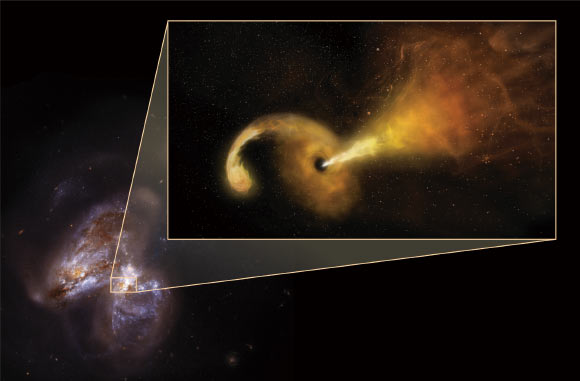A multinational group of astronomers has imaged the formation and expansion of a fast-moving jet of material ejected when the intense gravity of a supermassive black hole at the center of a member of the merging galaxy pair Arp 299 ripped apart a star more than twice the Sun’s mass that came too close to the black hole.

An artist’s conception of a tidal disruption event in the merging galaxy pair Arp 299; background is the Hubble image of Arp 299. Image credit: Sophia Dagnello / NRAO / AUI / NSF / NASA / STScI.
Only a small number of such events, called tidal disruption events (TDEs), have been detected, although astronomers have hypothesized that they may be a more common occurrence.
Theorists suggested that material pulled from the star forms a rotating disk around the black hole, emitting intense X-rays and visible light, and also launches jets of material outward from the poles of the disk at nearly the speed of light.
“Never before have we been able to directly observe the formation and evolution of a jet from one of TDEs,” said co-lead author Dr. Miguel Perez-Torres, a researcher at the Astrophysical Institute of Andalusia in Granada, Spain.
The first indication came on January 30, 2005, when astronomers using the William Herschel Telescope discovered a burst of IR emission coming from the nucleus of one of the Arp 299 galaxies.
On July 17, 2005, NSF’s Very Long Baseline Array (VLBA) revealed a new, distinct source of radio emission from the same location.
“As time passed, the new object stayed bright at infrared and radio wavelengths, but not in visible light and X-rays. The most likely explanation is that thick interstellar gas and dust near the galaxy’s center absorbed the X-rays and visible light, then re-radiated it as infrared,” said co-lead author Dr. Seppo Mattila, an astronomer at the University of Turku, Finland.
The team used the Nordic Optical Telescope on the Canary Islands and NASA’s Spitzer space telescope to follow the object’s infrared emission.
Continued observations with the VLBA, the European VLBI Network (EVN), and other radio telescopes, carried out over nearly a decade, showed the source of radio emission expanding in one direction, just as expected for a jet.
The measured expansion indicated that the material in the jet moved at an average of one-fourth the speed of light.

Animated gif showing expansion of radio-emitting region where a massive star was shredded by a supermassive black hole about 20 million times more massive than the Sun; expansion indicates jet of particles moving outward. Image credit: Mattila & Perez-Torres et al / Bill Saxton / NRAO / AUI / NSF.
“Because of the dust that absorbed any visible light, this particular TDE may be just the tip of the iceberg of what until now has been a hidden population,” Dr. Mattila said.
“By looking for these events with infrared and radio telescopes, we may be able to discover many more, and learn from them.”
Such events may have been more common in the distant Universe, so studying them may help astronomers understand the environment in which galaxies developed billions of years ago.
“TDEs can provide us with a unique opportunity to advance our understanding of the formation and evolution of jets in the vicinities of these powerful objects,” Dr. Perez-Torres said.
The research was published in the June 14 edition of the journal Science.
_____
S. Mattila et al. A dust-enshrouded tidal disruption event with a resolved radio jet in a galaxy merger. Science, published online June 14, 2018; doi: 10.1126/science.aao4669







